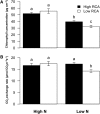Root cortical aerenchyma enhances nitrogen acquisition from low-nitrogen soils in maize
- PMID: 24891611
- PMCID: PMC4213101
- DOI: 10.1104/pp.114.241711
Root cortical aerenchyma enhances nitrogen acquisition from low-nitrogen soils in maize
Abstract
Suboptimal nitrogen (N) availability is a primary constraint for crop production in developing nations, while in rich nations, intensive N fertilization carries substantial environmental and economic costs. Therefore, understanding root phenes that enhance N acquisition is of considerable importance. Structural-functional modeling predicts that root cortical aerenchyma (RCA) could improve N acquisition in maize (Zea mays). We evaluated the utility of RCA for N acquisition by physiological comparison of maize recombinant inbred lines contrasting in RCA grown under suboptimal and adequate N availability in greenhouse mesocosms and in the field in the United States and South Africa. N stress increased RCA formation by 200% in mesocosms and by 90% to 100% in the field. RCA formation substantially reduced root respiration and root N content. Under low-N conditions, RCA formation increased rooting depth by 15% to 31%, increased leaf N content by 28% to 81%, increased leaf chlorophyll content by 22%, increased leaf CO2 assimilation by 22%, increased vegetative biomass by 31% to 66%, and increased grain yield by 58%. Our results are consistent with the hypothesis that RCA improves plant growth under N-limiting conditions by decreasing root metabolic costs, thereby enhancing soil exploration and N acquisition in deep soil strata. Although potential fitness tradeoffs of RCA formation are poorly understood, increased RCA formation appears be a promising breeding target for enhancing crop N acquisition.
© 2014 American Society of Plant Biologists. All Rights Reserved.
Figures










Similar articles
-
Reduced frequency of lateral root branching improves N capture from low-N soils in maize.J Exp Bot. 2015 Apr;66(7):2055-65. doi: 10.1093/jxb/erv007. Epub 2015 Feb 13. J Exp Bot. 2015. PMID: 25680794 Free PMC article.
-
Root cortical aerenchyma enhances the growth of maize on soils with suboptimal availability of nitrogen, phosphorus, and potassium.Plant Physiol. 2011 Jul;156(3):1190-201. doi: 10.1104/pp.111.175489. Epub 2011 May 31. Plant Physiol. 2011. PMID: 21628631 Free PMC article.
-
Low crown root number enhances nitrogen acquisition from low-nitrogen soils in maize.Plant Physiol. 2014 Oct;166(2):581-9. doi: 10.1104/pp.113.232603. Epub 2014 Apr 4. Plant Physiol. 2014. PMID: 24706553 Free PMC article.
-
Root phenes that reduce the metabolic costs of soil exploration: opportunities for 21st century agriculture.Plant Cell Environ. 2015 Sep;38(9):1775-84. doi: 10.1111/pce.12451. Epub 2014 Nov 17. Plant Cell Environ. 2015. PMID: 25255708 Review.
-
Steep, cheap and deep: an ideotype to optimize water and N acquisition by maize root systems.Ann Bot. 2013 Jul;112(2):347-57. doi: 10.1093/aob/mcs293. Epub 2013 Jan 17. Ann Bot. 2013. PMID: 23328767 Free PMC article. Review.
Cited by
-
A superior gene allele involved in abscisic acid signaling enhances drought tolerance and yield in chickpea.Plant Physiol. 2023 Mar 17;191(3):1884-1912. doi: 10.1093/plphys/kiac550. Plant Physiol. 2023. PMID: 36477336 Free PMC article.
-
A newly formed hexaploid wheat exhibits immediate higher tolerance to nitrogen-deficiency than its parental lines.BMC Plant Biol. 2018 Jun 7;18(1):113. doi: 10.1186/s12870-018-1334-1. BMC Plant Biol. 2018. PMID: 29879900 Free PMC article.
-
Evidence that variation in root anatomy contributes to local adaptation in Mexican native maize.Evol Appl. 2024 Mar 10;17(3):e13673. doi: 10.1111/eva.13673. eCollection 2024 Mar. Evol Appl. 2024. PMID: 38468714 Free PMC article.
-
Root-type-specific plasticity in response to localized high nitrate supply in maize (Zea mays).Ann Bot. 2015 Oct;116(5):751-62. doi: 10.1093/aob/mcv127. Epub 2015 Sep 7. Ann Bot. 2015. PMID: 26346717 Free PMC article.
-
Reduced root cortical cell file number improves drought tolerance in maize.Plant Physiol. 2014 Dec;166(4):1943-55. doi: 10.1104/pp.114.249037. Epub 2014 Oct 29. Plant Physiol. 2014. PMID: 25355868 Free PMC article.
References
-
- Azeez J, Adetunji M, Lagoke S. (2006) Response of low-nitrogen tolerant maize genotypes to nitrogen application in a tropical Alfisol in northern Nigeria. Soil Tillage Res 91: 181–185
-
- Barber SA (1995) Soil Nutrient Bioavailability: A Mechanistic Approach. John Wiley & Sons, New York
-
- Bouranis DL, Chorianopoulou SN, Siyiannis VF, Protonotarios VE, Hawkesford MJ. (2003) Aerenchyma formation in roots of maize during sulphate starvation. Planta 217: 382–391 - PubMed
-
- Burton AL (2010) Phenotypic evaluation and genetic basis of anatomical and architectural traits in the genus Zea PhD thesis. Pennsylvania State University, University Park
-
- Burton AL, Brown KM, Lynch JP. (2013a) Phenotypic diversity of root anatomical and architectural traits in Zea species. Crop Sci 53: 1042–1055
Publication types
MeSH terms
Substances
LinkOut - more resources
Full Text Sources
Other Literature Sources

